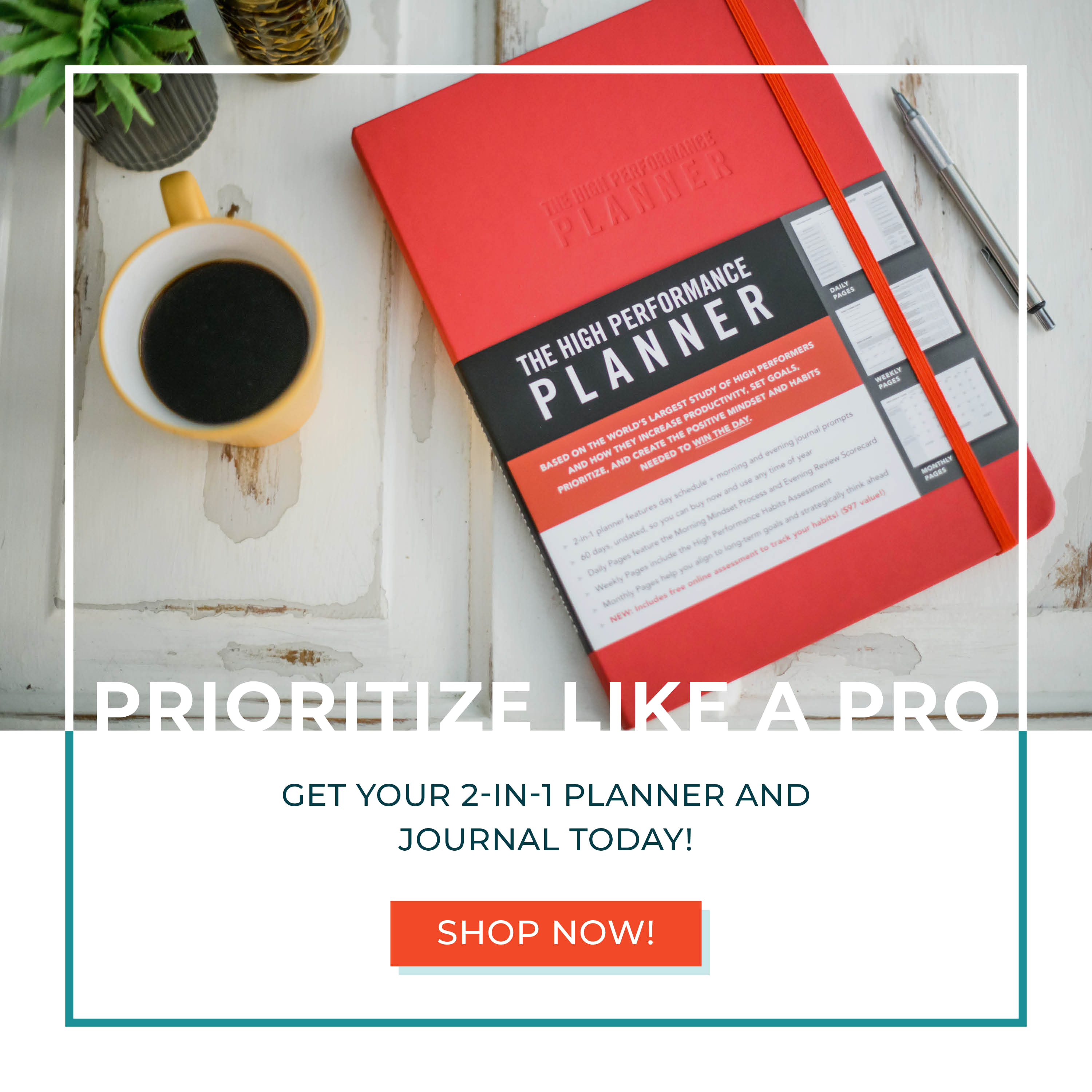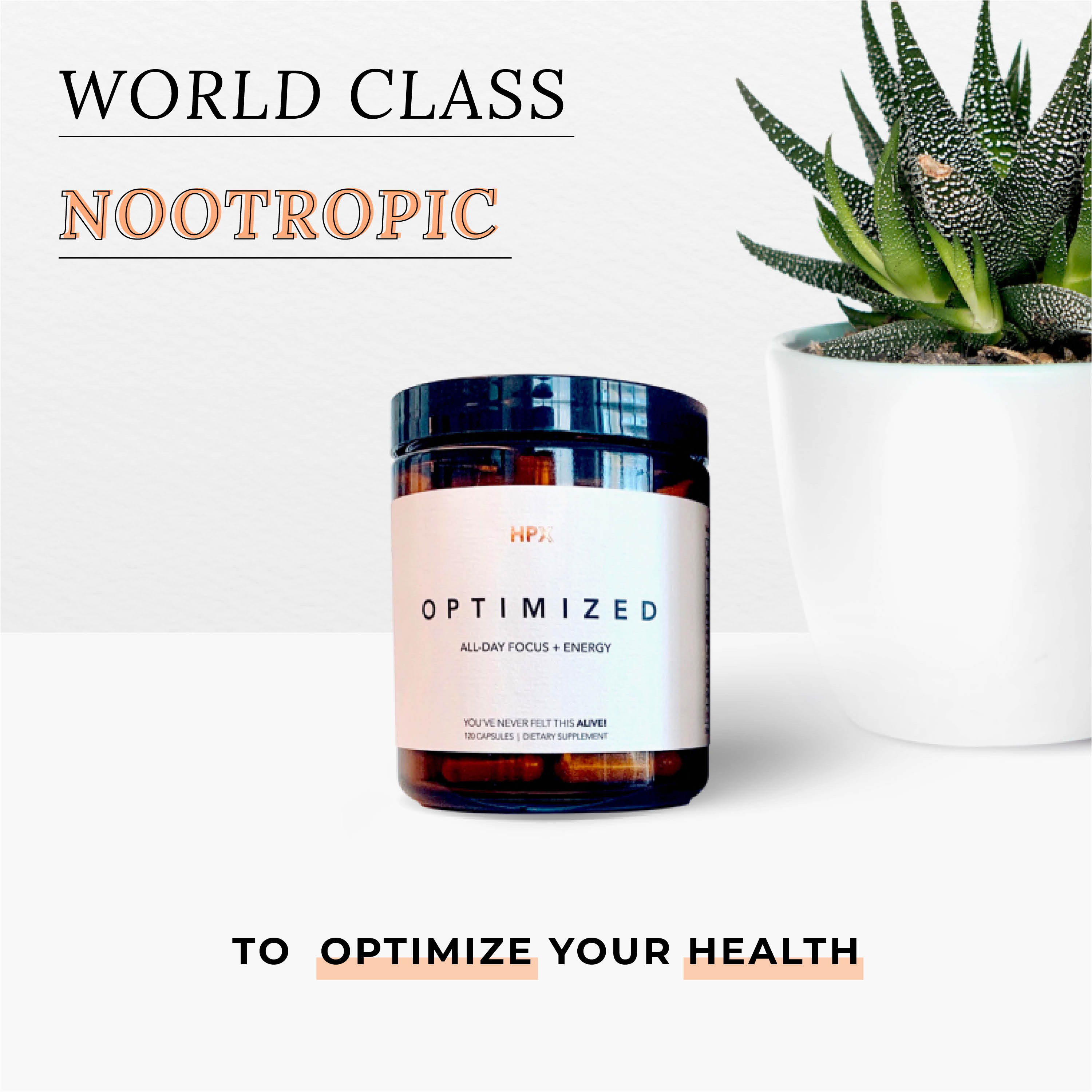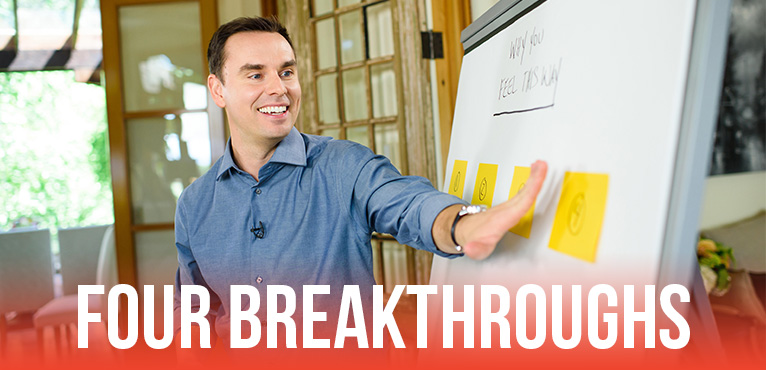SUMMARY
- “All results are going to come from habits. All good results over a period of time are the result of routines and habits that have been measured, enculturated, and grown.”
- As a development leader in your organization, do you have habits that align with the vision you’re trying to achieve for your team? Learn the six high performance habits that will take you and your team to the next level.
- “Whoever gets there first with their people, wins.”
- You are as good as the habits you have in place. In this special episode, learn the habits you should pay attention to and start developing NOW to reach high performance over the long term.
- Watch the video to get the full training.
- Already have the High Performance Planner and CRUSHING each and every day? Let’s celebrate you! Take a photo with your planner and use #HPXlife or #TeamHPX.
HOT NEWS & DEALS!
-
Join the Entrepreneur’s Challenge!
Sign up for my 7-day crash course and you’ll learn the strategies, tools, and revenue drivers needed to start (or scale) your dream business! Click here to sign up!
-
Get the High Performance System!
If you want to level up personally and professionally, High Performance System is the resource you need. The High Performance System will guide you through developing and implementing the 6 science-backed habits that will move the needle from ordinary to extraordinary. Develop the habits that lead to long-term success, positive relationships, and healthy well-being! Get the High Performance System!
DID YOU KNOW?
I give weekly prizes, gratitude and shout-outs to our students, so post a screenshot or video on Instagram and use #TheBrendonShow! I can’t wait to hear your thoughts about this episode!
RELATED POSTS
How to Track Your Personal Growth
How to Achieve an Action Mindset (and Stay Disciplined!)
How to Master Motivation
Want Change?Start with Yourself
One Mindset Shift to Quickly Increase Your Confidence
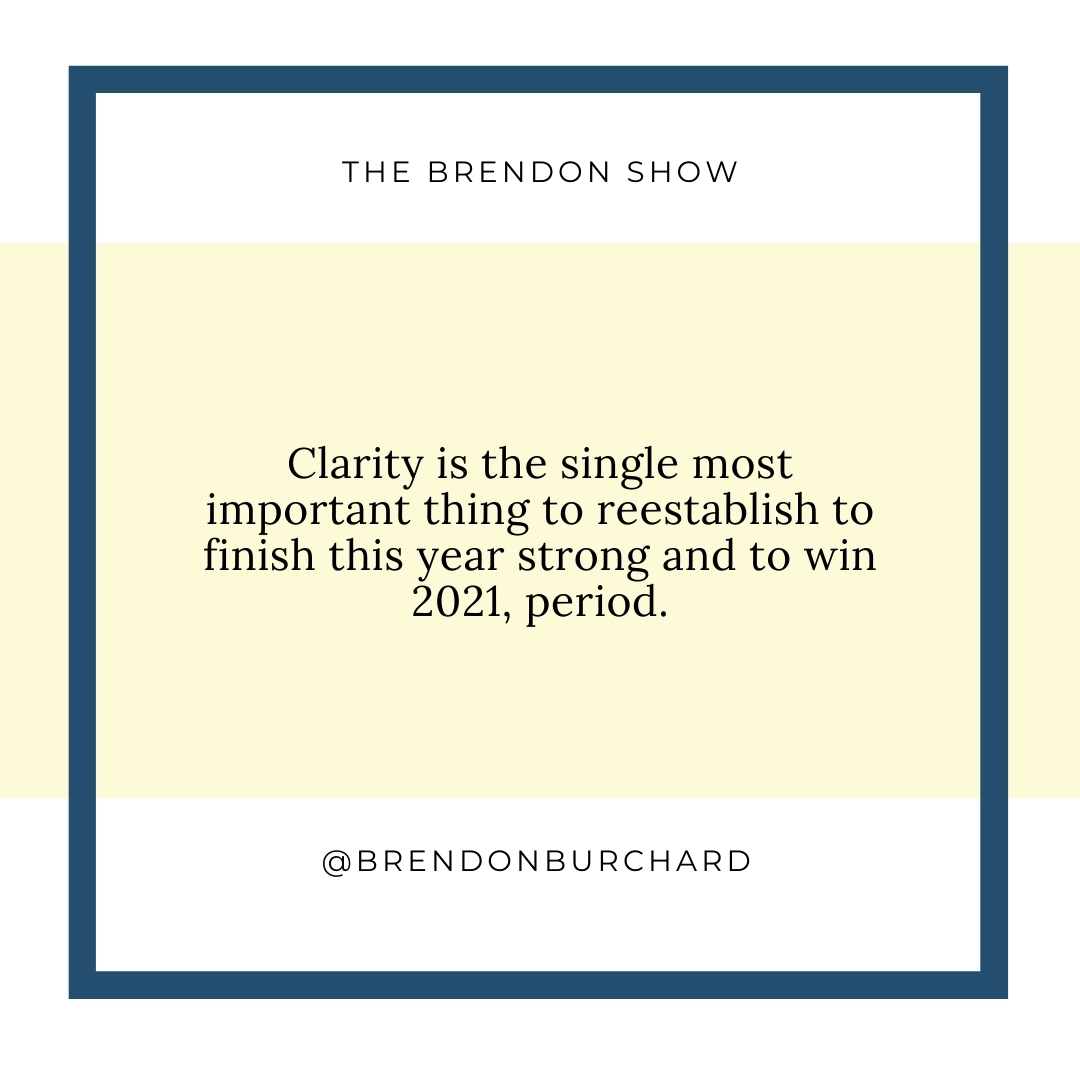
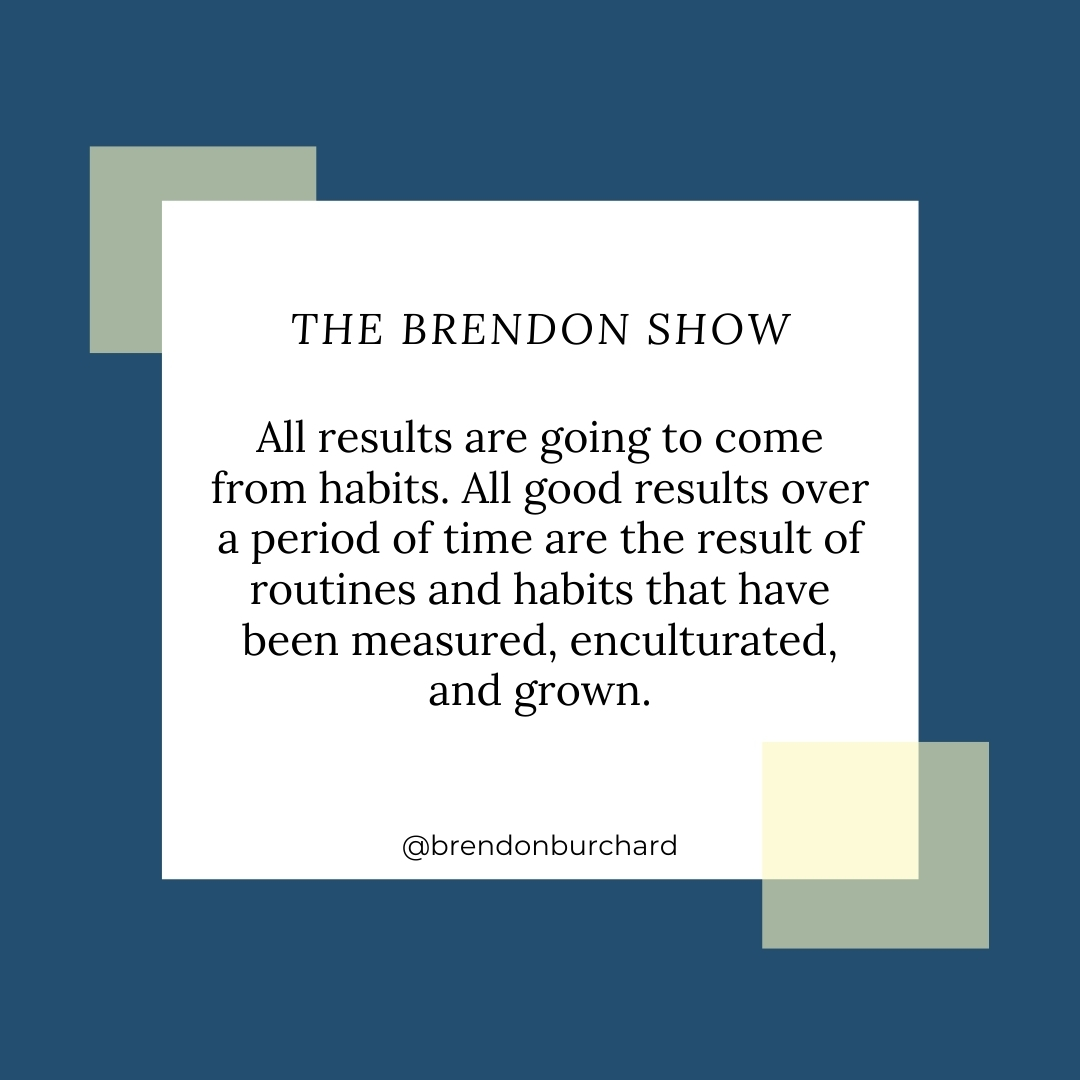
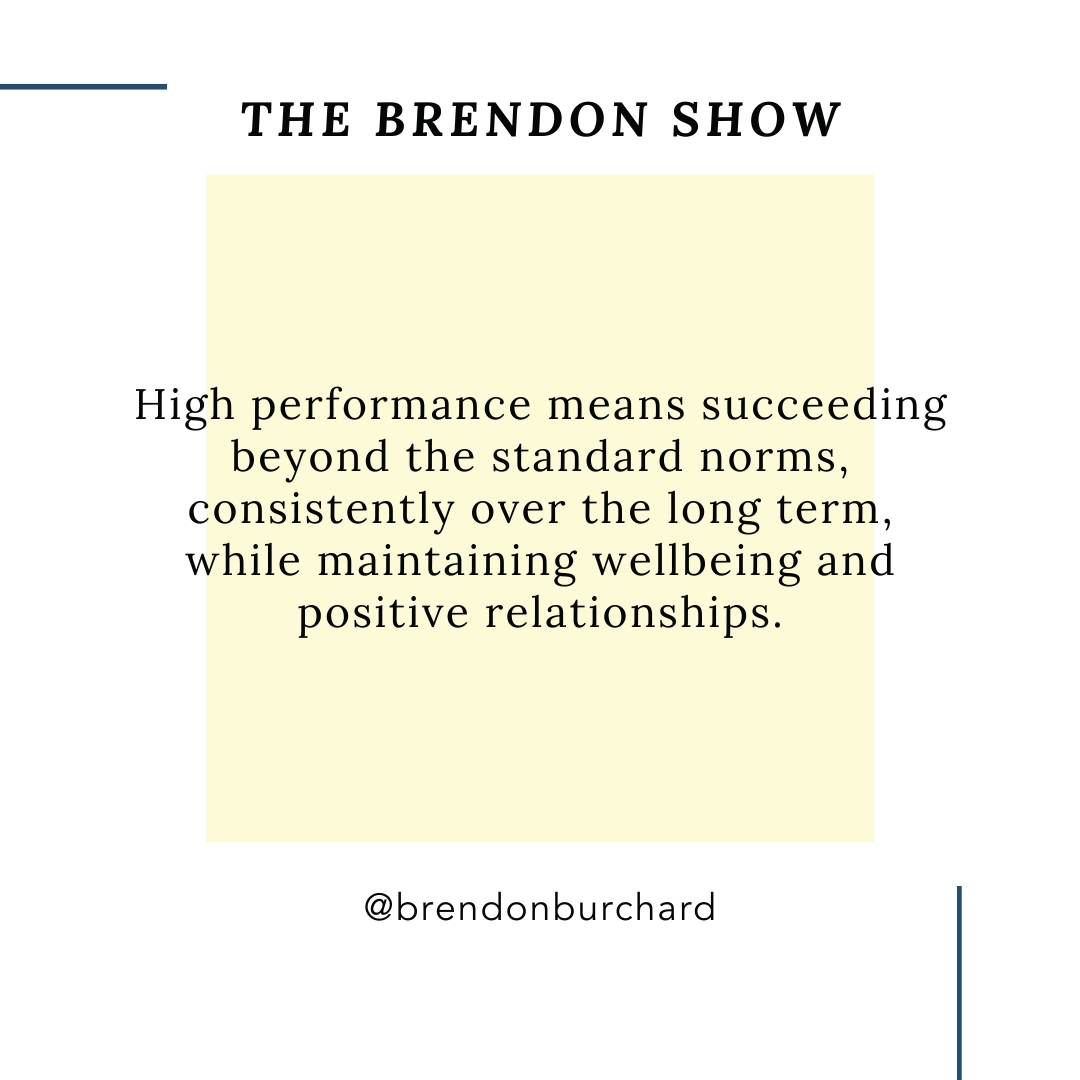
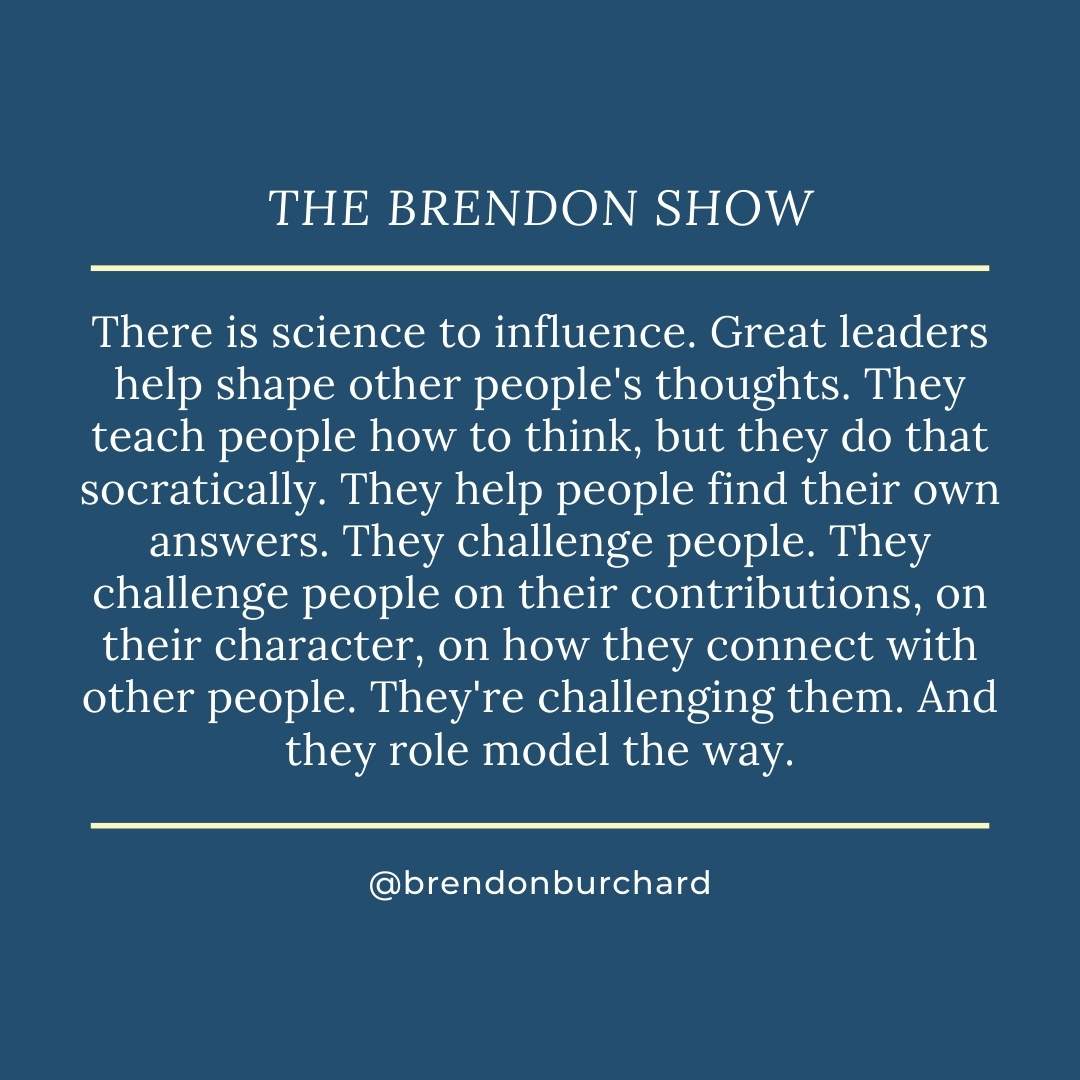
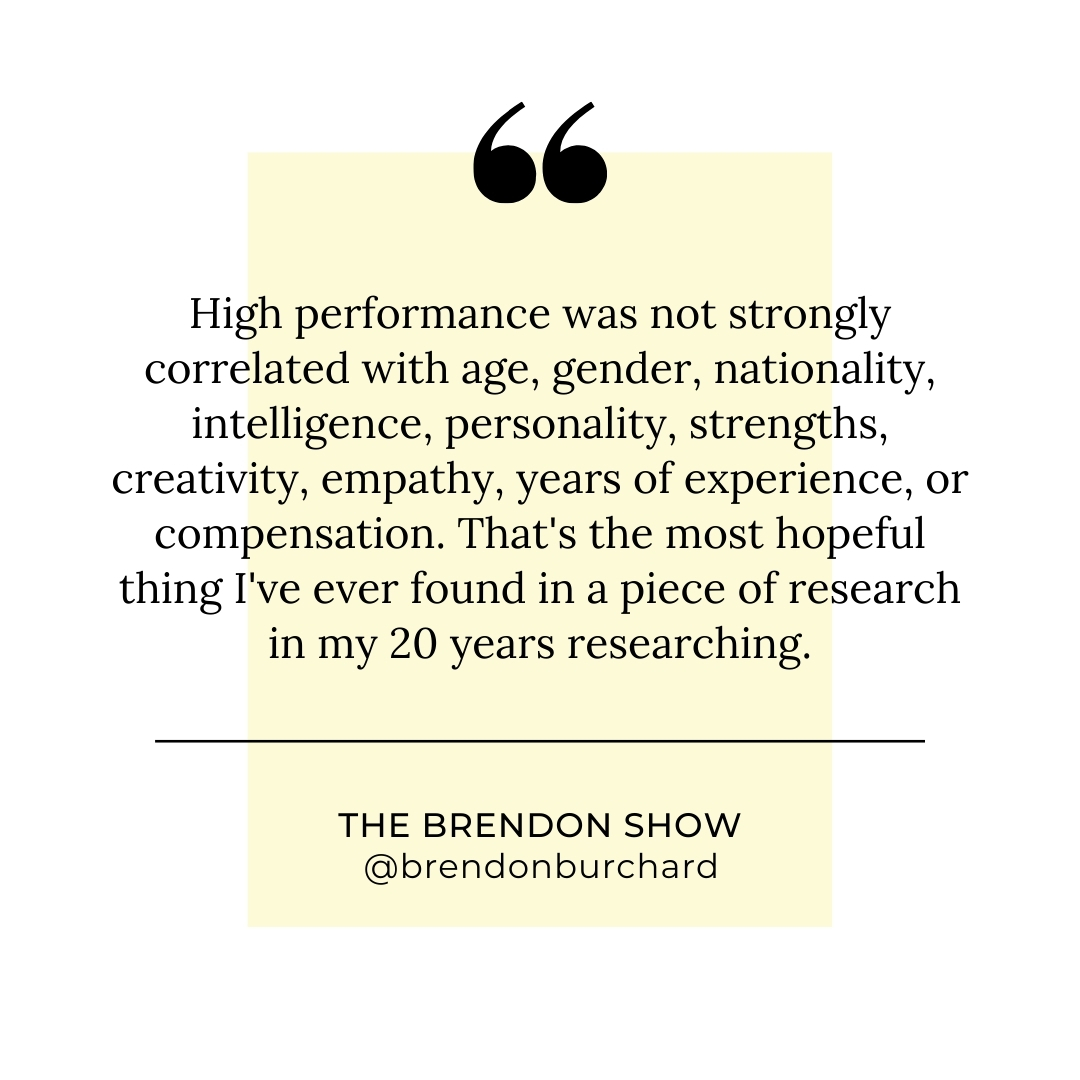
FULL TRANSCRIPT
[The following is the full transcript of this episode of The Brendon Show. Please note that this episode, like all TBS episodes, features Brendon speaking extemporaneously–he is unscripted and unedited. Filmed in one take, The Brendon Show has become one of the most viewed unscripted, direct-to-camera self-help series in the history of YouTube. It has also been the #1 Podcast in all of iTunes and is regularly in the top podcasts in Self-Help and Health categories around the globe. Subscribe to the free motivational podcast on iTunes or Stitcher.)
Hi everybody, I’m on the internet live with you! This is something that gets me excited and thrilled to be with you here today, because I know I get to talk to my tribe today. Getting the opportunity to speak with you, knowing the difficulties you have faced in 2020, knowing the challenges to be in your roles and in our roles, as leaders, as the people developers, as the HR professionals, as those who really care about the people, the organizations, and their performance—we got a lot to talk about today, right?
We all want to make sure we end the year strong but how, given all this turbulence. We all want to make sure that our culture is cared for, in this chaotic time, we all want to make sure we’re developing leaders, we all want to make sure that we care about people’s wellness, but we’re also aligned to moving the organizations forward. And how are we going to do that? That’s the essential question so much of my career over the last 20 years has been: how do you help people succeed over the long term, while maintaining their wellbeing, and their positive relationships with other people? Meaning how do you have success at an individual and a team level, that isn’t compromised by having a burnout, or having to step over people?
I really believe that’s a galvanizing mission right now for all of us. And I’ll keep saying all of us here today because no matter what you do, if you’re on something like this, you’re in the people development world. You are here to help people learn, to help them grow, to help and contribute, to help them lead. And this year’s tough.
I will share it right off the bat, I have a bias with you, and it’s a strong bias. If you know my work, I do a lot of research and I’m a sort of a nerd of history as well. And I deeply believe that this is the year where two groups of people are going to be undervalued and underappreciated. One of them certainly is teachers, as we see them adopting these new roles, and having to deal with the challenges. Parents are getting some attention by the media at least. But here’s who is not: you. I think the underappreciated role of this entire year is anyone in HR, organizational development, people development, great leaders, who are caring for their people in times of dramatic transition in the culture, in the workforce, where they work. This is a time in which the world will never quite understand how hard each of you have worked to guide your organizations and their people through this.
For some of you, you’ve had to pause people’s work lives, let people go, onboard people, change people, teach people how to use Zoom. I mean, you got to change policies, location. The HR professionals of this world are underappreciated, undervalued, and they don’t get their praises sung enough. So forgive me to be a little self-serving or self-righteous at the very beginning with you, but I deeply want you to hear that from me. I value the work that you are doing in the world, I think you are under appreciated, and this year’s story five decades from now will be so much about the people who showed up to help people transition and cope with these very difficult times in the workforce. And that’s the challenge, we’re not having that.
So, I’m here today to hopefully bring a little bit of spirit into this conversation, but also, the one mechanism that we know is going to make the greatest difference. When I talk about these things like performance, when you talk about productivity at work, when you talk about culture at work, when you talk about leaders at work, when we’re talking about wellness alignment, when we talk about coping with this year, there was one mechanism, one driver, one lever we all have the pull that we know from research. And you know from your history, your story, what you’ve learned in your life, that’s going to move the needle. Habits. That’s it.
We would love it to be lots of other things. As performance professionals, we often all get into thinking it’s going to be a hundred different performance variables but, I’ll give you a little bit of a teaser of the research here. We measured a hundred performance variables, across the highest performing people in 190 countries worldwide, and the difference maker in terms of their long-term success—and again, long-term success defined as they maintained wellbeing and positive relationships—came down to their habits.
There are just six specific performance habits I’d like to share with you, but also give a little insight into how you could use that to change the conversation right now in your organizations and with your people, which I know everybody desperately wants. Because we got to get people. We got to get our teams back onto level ground in a time when there was so much turbulence this year, so much confusion, so much vitriol, so much “what do I do,” so much change on what’s on people’s plates because their coworkers laughed or were laid off or now are remote. You’re trying to work from home and the kids are there, and the dogs are there, and the leaf blowers are there.
And you’re trying to figure out, “How do I stay sane during this time?” Well, everybody’s trying to figure that out. So our ground has shifted so much; we as professionals have to figure out: how do we get our people back on stable and confident ground? We’ve got to move the conversations using high performance, as a galvanizing phrase. Using habits, as a research-backed approach that we know will work, to move people from coping, with the craziness of this year, back into performance.
Now, I know when I say that it’s not as popular right now, it can seem insensitive if we’re not careful about it. But we must do two things at once. We have to take care of our people. That’s your role, right? You’ve got to take care of the people. And right now everyone’s trying to cope, and we’ve got to be there for them, we’ve got to serve them. I’m sure everyone watching, you created new policies, new ways of doing things. You worked so hard this year and a lot of it has been to help people adjust, adapt, cope.
But we also have to own right now, this huge shift has to happen, into moving it from just a coping conversation, just, “Oh my gosh, this is crazy. Here’s how we’ve adapted,” back into performance, so we end the year strong, and most importantly, set up next year to develop your leaders, to align your teams, to improve organizational results and performance, at a time it’s never mattered more, which will be Q1 of this next year.
So, how do we do that?
Well, we have to finish the year very deliberately, not just in reaction, not just in coping, but we have to start infusing the performance conversation, and the messaging, of our own people’s habits in order to get them aligned to greater performance outcomes for next year.
And I know I’m speaking your language here. I’m not telling you anything new on this. I’m hoping to just share a little bit of what we learned from the research.
Because, as of today, we’ve conducted the world’s largest study of high performance that’s ever been done. As I shared with you, we’ll talk about some of those results. But, we’ve got a lot of perspective here. And because it’s recent research, and it’s ongoing research, I think this is going to really help you grasp and hopefully utilize some simple concepts and tools that your people can understand, that they can get behind, that they can talk about and everybody can be on the same page about, which is just vital right now.
So I’ll share a little bit about my background for those who don’t know me, I’ll just share the personal part and then, the professional part. I’ve been obsessed about what helps people change since I was a 19 year old kid. Those who know my story, I was in a car accident when I was 19. Up to that point, I had been a very depressed, heartbroken young man. The love of my life at the time, my high school sweetheart, she had gone outside of our relationship and it broke me in pieces. It’s one of those things where if your identity has ever been tied up in a relationship, or a role, and that relationship or that role falls apart, you fall apart. And I fell apart. And I didn’t have the coping mechanisms, or the understanding of personal development or self-mastery, or all the things we all often take for granted in people development. I didn’t have the consciousness or the maturity.
And I fell into depression and later suicidal ideation. And fortunately, during that time, I had an accident unrelated, and the car accident taught me the preciousness of life. And it helped me realize—here I was this 19 year old kid and I had been suicidal a little bit. I didn’t want to take my life. The car accident made me realize I wanted life. It helped me realize I need to have reverence for it, I needed to care for it. And I felt like something opened up for me. A new understanding of life, and it made me more appreciative and it gave me what I—if you know my brand or what I’ve taught for over the years, it helped me understand the value of second chances. It helped me understand that what we all want at the end of our lives is to live fully, to love openly and completely, and to make a difference, to matter. “Did I live, did I love, did I matter,” became my mantra at 19 years old.
Last night when I went to bed, right after I cut my own hair, I know some of you are too. Guess what? I went to bed, I laid in bed, and I asked the same questions. Did I live? Did I love? Did I matter? I’ve gauged myself on that evaluative framework for 20, coming up on 25, years here. And so, it’s something I deeply cared about, because I wanted to restart, I wanted a second chance, and that got me into personal development. And once I started getting in personal development, I got into psychology. Once I got into psychology, I got into philosophy. Once I got into that, I got into leadership.
And so, for the last 20 plus years, I read a book a week on these topics. I identify mostly as a researcher, and secondly as a writer, and third as a coach, because that’s how I make my life and my living, and our brands and our companies—200 plus employees across all the different brands. I am somebody who spends a lot of time thinking about this.
What came to be really apparent to me was that those who succeeded long term, and who did it both quickly, but were able to sustain it, they must be doing something different and I wanted to be a success too. So I started understanding it. Then I started my own companies and worked for major companies. Worked for companies like Accenture. And when I was at Accenture, at the time we were 86,000 employees, I left by the time we were at 200,000. I learned a lot about the differences in people who succeed. And some people are “successful,” but they’re miserable. They’re miserable in their role, they’re disengaged, they don’t feel connected, there’s no real vitality and joy and fulfillment from what they’re doing, even if they have the high pay. So there’s a difference there. Some people succeed and they’re happy, and engaged, some people “get ahead,” but they’re miserable. And is that really getting ahead?
So I wondered what is it going to be that motivates people to reach higher levels of success in the first place, and what kinds of specific habits or training or tools or support are going to help them grow and improve? And that’s been my efforts. And just like many of you I learned along the way something that was revealed that was a long time ago from Aristotle, that all of that personal development, everything we do in our work life, the excellence—to quote Aristotle,
“Excellence is an art won by training and habituation. We do not act rightly because we have virtue or excellence, but rather we have those because we have acted rightly. We are what we repeatedly do. Excellence then, is not an act, but a habit.”
And I know I’m preaching to the choir because you know it. When you’re on, when you’re performing at your best in your own role, and it’s going. And you get it week after week, month after month, there’s a vibe, there’s an energy, there’s a spirit, there’s a joy, there’s a performance that’s happening there. And the question is, how do you give that to your people? How do you translate the concepts that you know about human behavior change into organizational change and excellence?
One vehicle: the habits that you as a culture are espousing, rallying behind, aligning, and measuring to. That’s it. We all know it.
All results are going to come from habits. All good results over a period of time are the result of routines and habits that have been measured, enculturated, and grown.
And so we have to go beyond—and this is mine personally. We’ve got to go way beyond where the conversation has been about success for a long time, because here’s what success usually looks like from a beginner-level leader, or a beginner-level when we’re trying to teach people individually how to succeed. It’s just like, “Oh, get into it, work really hard. Be passionate, focus on your strengths. Practice, practice, practice. Be grateful, be candid, stick to it, be consistent, be persistent.” This little arrow you see here, I bet every one of you—if I could see all your faces, you look at that arrow, I bet you know somebody who did all of those things and still didn’t make it, still didn’t have success. They did all of them. I know a lot of grateful people who aren’t at the success levels they desire. I know a lot of people who practice who are candid and honest, good humans, and they struggle. These are good starting things but we got to go way beyond that.
That’s what got me going. It was like, “I love this. This is good. This is personal development 101, isn’t it?” But sometimes a professional environment takes a little bit more. And so that’s what began my research. We basically began at the High Performance Institute studying the top performers in the world. So to give you an idea, we collected data from over 2 million people. We’ve had the blessing of watching, of assessing organizations, across hundreds of organizations, all around the world, 190 countries, to give you an idea. We’ve had online students who we’ve been able to measure and monitor their progress, where they’re stuck, where they’re facing difficulties. We’ve done the empirical research to study the literature, but also, had the empirical results of having the blessing of coaching over 40,000 people one-on-one, specifically on performance. Then I did over 400 structured interviews between myself and the team, with the top 5% of leaders in the world from 11 different industries to simply understand what was the difference maker.
And I want to let you know, I didn’t go in with a perspective on this. I had opinions and thoughts, but this was an academically-backed theoretical research study. We teamed up with academics from University of Pennsylvania Positive Psychology Department, and from UC Santa Barbara. And so we had psychologists leading us through to help us understand this. We had organizational development consultants working on the project. Myself, helping lead that, with the teams. And we got a lot of perspective.
What did we find out? Well, across a hundred different performance variables. These are the variables that inevitably you’ve all measured, you’ve studied. I’m not teaching anything new here. But what we did uniquely in the research is we said, “Okay, out of all the performance variables that make somebody “successful,” or a team “successful,” which ones were done on purpose?” They knew it wasn’t unconscious competence. It was: this person knows that they do these types of things and it gets them a result. Can we see that happen? Is that malleable? Can we change it, shift it, improve it? Is it trainable? Can you train this? And is effective across multiple domains, industries, roles, categories?
When we filtered out those hundred performance variables to that, it came down to six performance habits, which was surprising, frankly. And some of the things I thought would be on that list did not make that list, as well as almost every team member who was involved in the research study we were like, “Oh, there were a lot of things we personally thought would be there. It wasn’t there.” That’s the value of research, it’s to test your assumptions, and to go deep to understand what really moves the needle.
And I think some of you will find out today, some of the things we think move the needle most, don’t. And the things that do are often under appreciated, and worse, not institutionalized, not created, managed, communicated, measured, celebrated, or rewarded.
And so people are working real hard, but they’re not achieving high performance. So what do we have to do? We’ve got to understand what these performance variables are that basically matter the most. And so, what we found is there’s kind of two realms here of what matters the most: what you do personally, as an individual contributor, what your leaders do personally in their lives, what they do by themselves in their work life, in their home life—it could be anything. And then socially, what do they do with their teams? On the team? In the company?
And so there’s two different bubbles here. We’re going to talk about the personal habits of high performance. And then we’ll talk about the social habits of high performance. And here’s the deal. You cannot have an effective program, in any HR, organizational development, learning development, any effort with people, that does not specifically look at each of these six areas. Because if they don’t, what happens is you might help people become more productive, achieve a specific result, but their wellbeing drops. The positive relationships that they have at work, drop.
So there are lots of performance variables but I want to remind you high performance is specifically measured, and discussed, as a way to achieve long-term results, while maintaining well-being and positive relationships. And this is why, worldwide, high performance, this book, and the courses that we have, the tools that we have, the coaching that we have, the online assessments that we could give you, all of this has just—as you can imagine, this year, 10 next.
Because everyone’s going, “Oh, we need to figure out how to not just navigate this, but we’ve got to figure out how to take care of our people’s wellness and their relationships.” Because now, a lot more we’re working at home or remote, and so their relationships aren’t the same at the water cooler as it used to be.
And at the same time, the number one theme of 2020 is being able to care for one’s wellness amid all of this stress, amid the pandemic, amid the concerns, amid the challenges of a changing environment.
And so, high performance is something you must be talking about with your people, but don’t forget, it’s just about performance.
High performance is specifically correlated with long-term success, wellbeing, and positive relationships. You miss any of those pillars, we’re in trouble.
So I want to set that context, and get you excited about those things, because everyone needs those things. The question has been how? How? The habits. You need a habit specific program in your organization that everybody’s talking about. That everyone’s on the same page about and can align behind. And here’s why habits are so safe and so positive. Because they’re not just about people’s strengths or personality. And that’s important, because when you talk about performance, it just keeps coming back to personality, or style, or strengths, or horoscope, or Enneagrams. Guess what? That feels very judgmental. But behavior change driven by habits? That feels doable.
So we’re going to talk about that real briefly. Here’s what we found high performance to mean. It means specifically, if you’re watching this, on your desktop, go ahead and grab it a screenshot of this slide. Because this is a definition we’re going to move from.
High performance means succeeding beyond the standard norms, consistently over the long term, while maintaining wellbeing and positive relationships.
I love that. Ask your CEO what they want. They’re going to say that line, “Help us succeed beyond what we usually do, help us maintain it over the long term, help us take care of our people. That’s high performance.” And what’s cool is when you ask people who are the top performers in the world what it feels like when they’re high performing, these are the three words they use: “I feel fully engaged, I’m in the moment, I love what I’m doing.” We know that part, but there’s joy there. There’s joy, there’s enthusiasm. And there’s confidence. Because there’s mastery, there’s competence, as you and I would talk about in our careers. So think about it; if we could give your team full engagement right now. How hard is it getting people to engage in Zoom? How hard is it to get people engaged when they’re remote? It’s hard right now. You have to have some tools for that.
How do you bring out energy, positive psychology, empathy, compassion, enthusiasm, and joy for other people in dark times? And how do you find your competence when you’re struggling? When you don’t know what tomorrow looks like? That’s the stuff of these habits. These habits give these results. That’s why it’s an exciting time to talk about this. I want to share the high performance in the research. This is really key, for professionals like us, who really care about this and for what you do in your teams and organizations.
High performance was not strongly correlated with age, gender, nationality, intelligence, personality, strengths, creativity, empathy, years of experience, or compensation. That’s the most hopeful thing I’ve ever found in a piece of research in my 20 years researching.
And when I say this, I mean, think about it. Really look at this. This means there is nothing more—perhaps inclusive—than habits. There’s nothing more inclusive than habits. Because we can talk about habits. And we understand that they are things that we do, not just who we are. And this discussing habits is a way to get away from the concerns of discrimination. Discussing observable, shared, performance habits, even frees us when people don’t get the exact result we needed them to get, because we have a process to examine. And I think this is important. I know I was getting a lot of blow back on this research when people see this for the first time, and they haven’t studied a lot of literature and performance. I know that’s not you all, but it’s so funny because people say, “Well, high performance must be tied to compensation.” And I’m like, “How many of you all know somebody who’s highly paid, but not high-performing at work?” You know what I’m saying? Who’s worked for a manager who got paid a lot, but didn’t do squat? You know what I’m saying? So no, pay doesn’t mean you’re good. Just cause you could pay more, you’re going to perform more. You’ve all learned that, we all know that, as compensation professionals, right? We also know it’s important. It’s not about personality and strengths, which is so freeing for those of us who’ve ever taken assessments that measured one of those things. Then we felt bad about ourselves, because we didn’t get the results we wanted. I think this is a very important point, so please allow me to hammer it a little bit.
The research showed that high performance is not about one’s strengths. Because a lot of people have strengths, but they don’t have the right habits to get stuff done. And here’s what we found out, high performers did not report working on their strengths any more than other people do. I know that sounds crazy. But listen to this, it’s because high performers ask themselves less often, “Who am I? And what am I good at, naturally?”
Instead they say, “What’s required to be of value and service here? And how do I grow into that and lead others and deliver that value and service?” It’s the question, not of strengths, but what is required to be of service?
And tell me, that’s not vital this year. Think about that. How many of us have strengths that just got blown out of the water this year, and we had to adapt?
Adaptation, the ability to understand what needs to happen in an organization to be most productive or prolific, or of service, outweighs the strengths.
Listen, I wouldn’t be here with you, if I was here just based on my natural strengths. This is supposedly the strengths-based movement, which by the way, I’m not discounting. I’m just saying it correlates less with long-term success, wellbeing, and positive relationships, than these six specific habits. So please hear me, I am not discounting the strengths revolution. I think it’s a wonderful conversation, I think there are great tools and coaches all around the world on this topic. It’s just, we found something that is correlated way higher than that.
Only because a lot of the strengths we naturally have at birth, or we find a proclivity to, aren’t always the things required to lead and serve at the next level of performance.
Because remember high performance: long-term continued consistent success. That requires growing into one’s role, into one’s capability, into one’s potential. And isn’t that why we all do the work? We don’t do the work just to celebrate what someone’s good at. We also do the work to develop that person to their full potentialities. In being of service to the context required.
My personal example is, I want you all to know, I was a mortified person in terms of public speaking. Yeah, me, I’m the guy now who has 26 online courses. I speak pretty much every day to 10 to 15,000 people every single day, whether it’s by Zoom or out there. And when I used to be out on the road, I had the blessing of having videos with 300 million video views, over 25 million hours of my training. Our courses have now been consumed worldwide. 25 million hours, that’s a lot. So you can tell I’m kind of long winded.
I was mortified of public speaking, but I recognized, just like many of you, to go to another level of service in the world. I had to get outside of my comfort zones, where my strengths lied, and develop new competencies. And I know we all live for that, but I think that got lost in a little bit of just “celebrate people’s strengths.” That stuff. And what we found in correlations is these six habits are more important, only because of that context of, I need to learn how to serve, I need to grow into who I must become, in order to serve at the level required of me, or that I desire.
So what would we be making practical? Six specific things. Let’s walk through each of these right now.
1. Seek Clarity
Okay, number one, the number one personal habit of high performers is that they seek clarity more often than under performers. Seek clarity. Notice it doesn’t say get clarity, because clarity has never gotten and locked, right? Seeking clarity means the adoption of the learning mindset, the growth mindset. It’s the person at work who you have to remind them, “Hey, make sure you prepare for the meeting.” And ask, “What is the outcome of this meeting? What do we want to achieve?” The person who does that is seeking clarity. Before they go into any performance environment they’re asking, “Oh, what’s required of me here? What will be of service to me here?”
Many of you know, I’ve had the blessing of teaching high performance to Oprah Winfrey and her entire leadership team. And one thing that I learned in that process of developing courses with her and doing other work with Oprah, was that she starts every meeting by saying, “What’s the intention of today’s meeting?” I think everyone knows, Oprah is a pretty high performing person. And she achieves that by starting with what’s our intention. That’s a practice of seeking clarity. Well, we’ve got to help people seek clarity for themselves right now. And that clarity is a practice of a set of questions, around themselves. There’s like four different categories of clarity. And this might be helpful to you, even for those of you working from home.
We’ve got to seek clarity of self.
Who am I?
What am I about?
What do I find engaging?
What do I find fulfilling?
How do we socially add value?
How do we socially connect with other people?
How do we intend to treat other people?
And what do we need from other people?
We have to seek clarity about the skillsets we need to develop to achieve our goals. And we have to seek clarity about the service that we want to provide. The things that we find purposeful, meaningful. We’re seeking clarity constantly; self, social, skill and service. Memorize this: we’re seeking clarity, self, social, skill, and service.
And as we help people find clarity there, we found from the research, they find more confidence. As we help people find clarity there, every single one of the other habits scores rise.
That’s how powerful that is. And let me tell you this, when you get your organization aligned because clarity is there; clarity in where the company’s going, clarity in what matters the most, clarity on how we’re all measured, clarity on what winning even means, clarity on the difference between you and the competitors, clarity on how we should treat each other.
Clarity is the single most important thing to reestablish to finish this year strong and to win 2021, period.
And if we don’t get organizations aligned with clarity, we cannot win, we cannot change, we cannot pivot, we cannot adapt.
Adaptation is a function of increased clarity, as long as it lasts.
So that’s why we say seek clarity. We’ve got to teach organizations and teams and leaders to continually seek clarity, to be open minded, to ask the questions, to keep reestablishing what’s important.
2. Generate Energy
Second big idea, we’ve got to generate energy. And you all love this. This is a topic, really of wellness. If you will. That, we’ve got to generate energy and be responsible for the energy that we are bringing into our workplaces, and we’ve got to teach our leaders, and our employees, and our teams, that listen, “Energy really matters.” The energy you’re projecting, how you’re dealing with the energy coming at you. And specifically, how do you take care of yourself, your wellness?
Energy has everything to do with how you manage stress, how you take care of the physical body, how you build a culture that has a vibe.
And the personal habits of high performers, they’re very conscious of their energy. I always share that high performance isn’t something that happens. It’s something that is generated. Energy is generated. I would say the power plant—if you think of a power plant—a power plant doesn’t have any energy. A power plant takes energy from one level, one source, transforms it into a higher level of utilization, then transmits it to the world. In other words, a power plant generates energy from a lower level and transmits it to a higher level. This is what we must do now.
We must change the tone and the energy in our organizations from coping in fear into confidence, direction, collaboration, alignment, and an excitement to perform again.
We’ve got to do it.
3. Raise Necessity
Third thing we have to do, and third thing that high performers do, is they raise necessity. Raise necessity, what does that mean? It means that high performers in any given performance situation raise psychological necessity, raise the stakes, to perform well. They don’t go through the motions.
They say, “It is vital and important that my performance today is on point, is focused, is driven towards outcomes that matter. It matters to me that I succeed here.”
And personally allow me to call this hunger. We call this hunger. This is, “I must do well for others. I must raise my A-game, so that I can contribute, serve, and help other people.” That is what we mean by this, raise necessity. So we have to teach our people to do that. Otherwise they just go through the motions. They stay hunkered down, and they don’t understand the necessity of performing high right now.
A lot of people, they should know it. A lot of people should be aware that there’s a crisis right now. But they don’t. And you know that, some of you coach people like that, and you’re working like, “Why aren’t they rallying right now?” Because they’ve never been taught how to raise necessity. No one naturally raises necessity. You have to teach it. I work with Olympians, like gold medalists, Olympians. They don’t naturally do this.
You have to summon a different level of motivation to perform at your top levels. And you have to do it consistently.
You all had that great conversation with a team member or an employee or a leader, you walked out, and you know what? They were awesome for a week. The next week they fell apart. You’re like, “What happened?” Then you went in and worked with him again, it gave him a new boost of necessity. “Oh, it’s important that I succeed here.” Ah, they got back on. So raising necessity is something you build into your habits as a professional working with others.
Okay, let’s talk about social habits. So we switch gears here. This is what high performers do with others. Those first habits I’ve walked you through, those personal habits, I’ll walk you through those again.
Seek clarity. Generate energy. Raising necessity.
Those are the internal game if you will. We need to teach leaders how to win the internal game. This is the self-awareness slide for those who liked that phrase. Now we’re into social habits. What do we actually do out into the world?
4. Increase Productivity
First thing, we increase productivity. Obviously high performers are increasing productivity. They’re good at that. How do they do it? How do you get people working from home, and over online tools now, performing at higher levels than they’d ever done before. We have to teach people how to increase productivity. How do we do that?
Well, there’s ways of teaching competency mastery, but there’s also teaching people about PQO. This is something learned from the research. PQO means Prolific Quality Output.
Prolific Quality Output. It means high performers have aligned their focus and their output with organizational goals that matter. This means they avoid distraction. This means they don’t take on too much. This means that they set boundaries. This means they know how to collaborate with people. This means they are aligned to what matters the most, and as we’ve all learned from research, people like Stephen R. Covey, people in the past, Peter Drucker. The main thing is to keep the main thing, the main thing. I mean, every productivity teacher of all time had said that in some way or another.
Productivity really requires a tremendous amount of focus on PQO, Prolific Quality Output. What are the outputs that matter the most here? How do we increase those and make sure that they align with organizational outcomes that we’re really after?
And then again, the question is of high performance? How do we do that without burnout, managing stress, and keeping positive relationships here?
5. Develop Influence
Next up, develop influence. Don’t you and I live for this? Helping leaders become leaders, helping leaders become better leaders. Helping people understand how much they influence their coworkers, the culture, the energy, the workspace. I mean, how important is this right now? And you and I, if we were sitting across the lunch table right now, we could have a conversation about this, and we would see culturally, all over the globe, that people are failing to understand how to have a good influence.
When we lack leadership, or when people aren’t able to have honest discussions, aren’t able to be authentic or transparent, and aren’t able to galvanize one another to work together, we have societal problems.
But you see this in your organizations, all the time. Leaders who have strengths, leaders who are liked, but they couldn’t lead anybody to the lunchroom. You know what I’m saying? Like influence.
There is science to influence. Great leaders help shape other people’s thoughts. They teach people how to think, but they do that socratically. They help people find their own answers. They challenge people. They challenge people on their contributions, on their character, on how they connect with other people. They’re challenging them. And, they role model the way.
This is actual science, to influence. Not a, “We’d sure like a better leader, but we don’t know how…” No, those are the three pillars of developing influence. And once we lock that as a habit in, and people know that they’re doing it on purpose, now we can develop greater influence on your teams.
You develop greater influence on your teams, what else happens? You increase productivity, you increase performance. The culture feels better. Leaders are more enabled. I mean, the alignment happens. Almost everything lacking in an organization tends to come from clarity, the first habit, and influence, the ability to influence productive ends.
So, as I shared that with you, you see how all these habits tie together to create high performance.
6. Demonstrate Courage
And the last big piece, develop courage. High performers are developing courage. They’re in there empowering courage on their teams, and in the organization, in their culture. They’re allowing and creating safe spaces for people to contribute, but to take bold action that is rewarded, and not vilified. You’ve not seen a lot of celebration of the courage that has happened this year. But I don’t know about you and how you celebrate your teams, but I hope you are celebrating the courage. It takes a lot of courage to adapt to this environment. If you’re on something like this, I celebrate you, because you’re still learning in a very difficult time. It takes a lot of courage to keep going, to try new initiatives, to try new tools, to try to change things. And you’re doing that.
So, these are the high performance habits:
- Seek clarity.
- Generate energy.
- Raise necessity.
- Increased productivity.
- Develop influence.
- Demonstrate courage.
And what you will love like I learned, is each of these has its own framework, each of its has proven practices. We have tools that measure these things.
If you’re going to focus on something to end the year strong and make next year extraordinary, it must be habits.
There are specific ones to measure and specific ones to roll out.
I hope this served you today. I’d like to end real briefly by just saying to you, I honor your work, you are underappreciated and undervalued, but I want to let you know, each of us watching this right now, we get it, and you get it. Your role, right now, is the most pivotal role in your organization’s future. Because if you get the people performing again, if you get the culture aligned again towards performance outcomes, that will save the company, grow the company, and expand the company during this time. You’ll have a competitive advantage that will never be able to be caught up on.
Because whoever gets there first with their people, wins.
